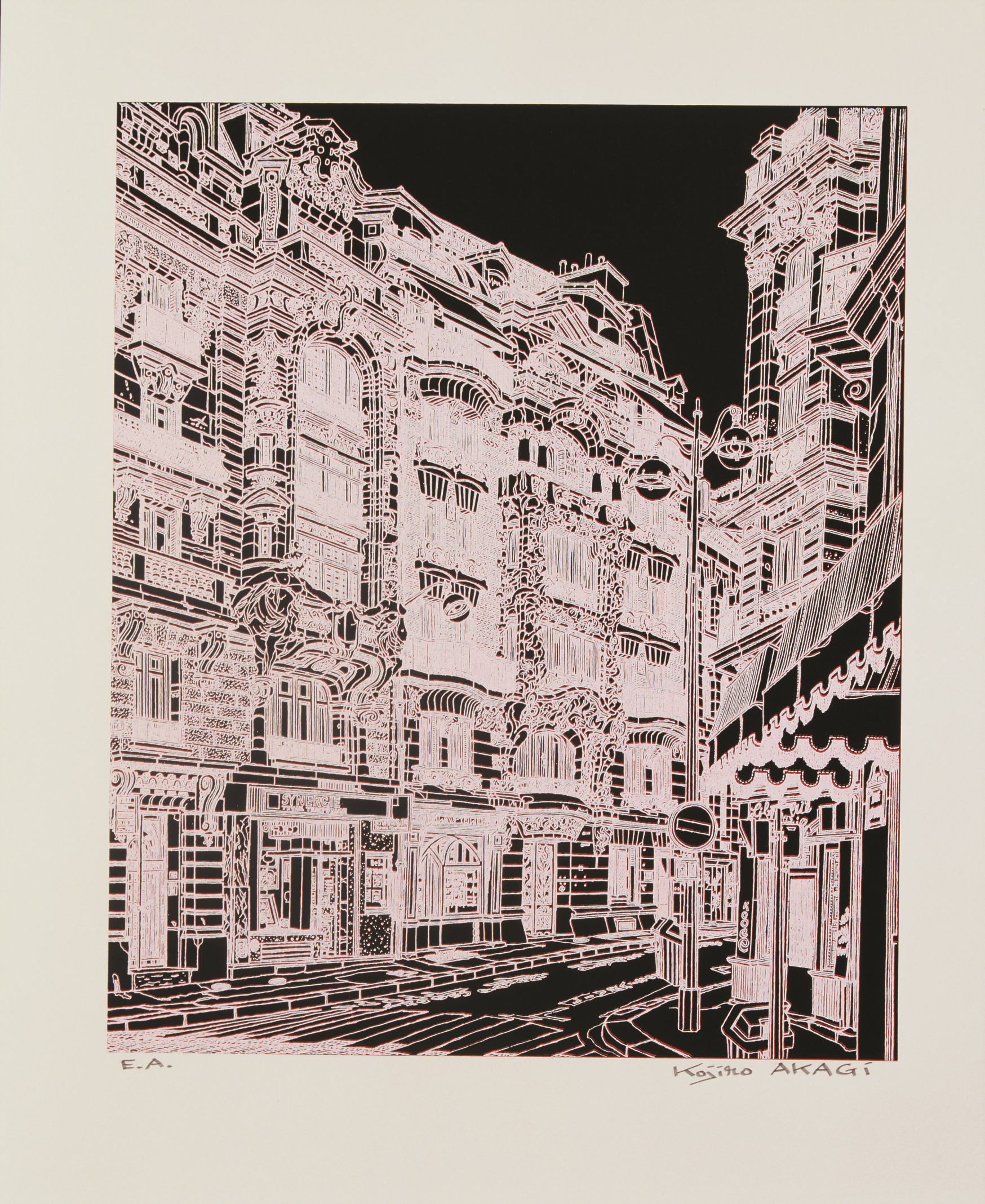Rue d’Abbeville / The Rue d’Abbeville / アベビル通り
Dublin Core
Title
Rue d’Abbeville / The Rue d’Abbeville / アベビル通り
Subject
Rue, Sérigraphie
Description
Cette rue est ouverte en 1827 et baptisée rue d’Abbeville en 1847, lorsqu’elle est prolongée en direction de la ville côtière d’Abbeville. C’est une rue calme, sans particularité. Je l’ai pourtant dessinée pour ses deux bâtiments singuliers au carrefour de la rue du faubourg Poissonnière. Sur la gauche, un immeuble réalisé fin 19e, sur la façade duquel on aperçoit de grands balcons ornés de sculptures de femmes dénudées. Ce style était très en vogue à l’époque. Mon regard a tout de suite été attiré par leur originalité et je m’interrogeais sur ces deux bâtiments richement décorés, côte à côte, en me demandant pourquoi ils étaient si différents des autres. Il s’agissait en fait d’un programme d’investissement immobilier dans une zone toute proche d’un quartier populaire. Le bâtiment voisin a reçu un Grand Prix lors de l’Exposition universelle de Paris en 1900, pour l’esthétique de son architecture. Cet ensemble est le reflet parfait de l’esprit de l’Art Nouveau, alors à son apogée. Dans son roman L’Assommoir, Emile Zola décrit cette rue comme triste et sombre. Au 19e siècle, les ouvriers de banlieue l’empruntaient le matin pour aller travailler et le soir, pour rentrer, d’un pas lourd et silencieux.
This street was opened in 1827 and started to be called by the current name when the road extension was finished in 1847. It may have been named so because it runs in the direction of the coastal city of Abbeville in Normandy. Although it is a quiet and nondescript street, there are two distinctive buildings in line at the crossroads with the Rue du Faubourg Poissonnière, so I drew them.The building right before them is the one with a balcony adorned with large sculptures of naked women, which were in fashion when they were built at the end of 19th century. It was a luxurious investment in the outskirts of the Place. The neighbouring building was built with an architecture design which won the first prize at Paris Universal Exposition in 1900. This building typified the essence of the most popular style at that time, art nouveau. Unintentionally, I look up wondering why there are two incongruous, magnificent buildings in a place like this.In Emile Zola’s novel “L’Assommoir” this is the gloomy slope where workers who live in suburbs in the 19th century walk down towards the centre of Paris in silence in the morning and return, once more, in silence, in the evening.
一八二七年から開かれた通りだが、一八四七年道路が延長工事されたおりに、現在の名前になった。ノルマンジー地方の海岸都市アベビルの方向に向かっているからこの名前になったのだろう。何気ない静かな通りだが、フォーブル・ポアソニエー通りとの交差点に、異常に目立つ建物が二つ並んでいて、絵に描いた。 手前の建物は十九世紀末に建てられた当時の流行の大きな裸体像彫刻でバルコニーが装飾された建物。場末に近いところに豪華な投資をしたものだし、その隣は一九〇〇年パリ万博の一等賞になった建築デザインで作られた。当時流行の頂点、アールヌーボーの香りいっぱいの建物が、実現したものだ。二軒並んで、何故こんなところに不似合いに立派な、と思わず上を見上げる。 エミール・ゾラの小説「居酒屋」では、朝黙々と郊外に住む十九世紀の労働者が、パリ市内に向けてこの坂道を下り、また黙々と夕方帰って行く、陰気な坂道だからだ。
Creator
Kojiro Akagi (1934-2021)
Date
Juillet 1992 / July 1992
Rights
Fonds de dotation Kojiro AKAGI
Format
Sérigraphie, Atelier Del Arco, 50 tirages + 9 E.A. romain, sur papier Arches 49,5 x 64 cm.
Type
Sérigraphie
Tags
Citation
Kojiro Akagi (1934-2021)
, “Rue d’Abbeville / The Rue d’Abbeville / アベビル通り,” Kojiro Akagi - Fonds de dotation Kojiro AKAGI , accessed December 27, 2025, https://kojiroakagi.com/gallery/items/show/63.

